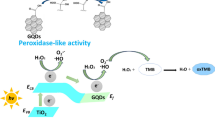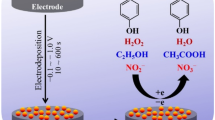Abstract
A selective and sensitive method is reported for the detection of dopamine (DA) by using electro-reduced graphene oxide (er-GO) supported walnut shape nickel nanocomposite (er-GO-Ni) modified glassy carbon electrode. The surface morphological characterizations reveal that the Ni nanoparticles were homogeneously distributed on the er-GO nanosheets. Subsequently the electrochemical study shows an excellent selectivity, reproducibility, low detection limit (10 ± 0.03 nM), high sensitivity (23.3 nA·μM−1), and reasonably wide linear range (0.05–50 μM) for the detection of DA at +0.1 V vs SCE. The selectivity for DA over ascorbic acid and uric acid is attributed to the charge-based discrimination of the modified electrode. An excellent correspondence of calculated and reported rate constant for the DA oxidation is also obtained by hydrodynamic experiments using a rotating disk electrode.

Selective detection of dopamine is demonstrated and assumed to be due to (i) a Nafion film coating, (ii) repulsive electrostatic interaction with the negative charge on residual oxygen functionality of electro-reduced graphene oxide (er-GO), and (iii) the presence of oxide or hydroxide Ni species during deposition of sample.








Similar content being viewed by others
References
Li D, Muller MB, Gilje S, Kaner RB, Wallace GG (2008) Processable aqueous dispersions of graphene nanosheets. Nat Nanotechnol 3:101–105
Kim Y, Bong S, Kang Y, Yang Y, Mahajan R, Kim J, Kim H (2010) Electrochemical detection of dopamine in the presence of ascorbic acid using graphene modified electrodes biosens. Bioelectron. 25:2366–2369
Wang Y, Li Y, Tang L, Lu J, Li J (2009) Application of graphene-modified electrode for selective detection of dopamine. Electrochem Commun 11:889–892
Liu S, Yan J, He G, Zhong D, Chen J, Shi L, Zhou X, Jiang H (2012) Layer-by-layer assembled multilayer films of reduced graphene oxide/gold nanoparticles for the electrochemical detection of dopamine. J Electroanal Chem 672:40–44
Sun C, Lee H, Yang J, Wu C (2011) The simultaneous electrochemical detection of ascorbic acid, dopamine, and uric acid using graphene/size-selected Pt nanocomposites. Biosens. Bioelectron. 26:3450–3455
Sanghavi BS, Wolfbeis OS, Hirsch T, Swami NS (2015) Nanomaterial based electrochemical sensing of neurological drugs and neurotransmitters. Microchim Acta 182:1–41
Tsierkezos NG, Ritter U, Thaha YN, Downing C, Szroeder P, Scharff P (2016) Multi-walled carbon nanotubes doped with boron as an electrode material for electrochemical studies on dopamine, uric acid, and ascorbic acid. Microchim Acta 183:35–47
Zhao D, Fan D, Wang J, Xu C (2015) Hierarchical nanoporous platinum-copper alloy for simultaneous electrochemical determination of ascorbic acid, dopamine and uric acid. Microchim Acta 182:1345–1352
Xing L, Ma Z (2016) A glassy carbon electrode modified with a nanocomposite consisting of MoS2and reduced graphene oxide for electrochemical simultaneous determination of ascorbic acid, dopamine, and uric acid. Microchim Acta 183:257–263
Rafati AA, Afraz A, Hajian A, Assari P (2014) Simultaneous determination of ascorbic acid, dopamine, and uric acid using a carbon paste electrode modified with multiwalled carbon nanotubes, ionic liquid, and palladium nanoparticles. Microchim Acta 181:1999–2008
Palanisamy S, Ku S, Chen SM (2013) Dopamine sensor based on a glassy carbon electrode modified with a reduced graphene oxide and palladium nanoparticles composite. Microchim Acta 180:1037–1042
Wang Q, Tang QL (2015) Improved sensing of dopamine and ascorbic acid using a glassy carbon electrode modified with electrochemically synthesized nickel-cobalt hexacyanoferratemicroparticles deposited on graphene. Microchim Acta 182:671–677
Hsieh YS, Hong BD, Lee CL (2015) Non-enzymatic sensing of dopamine using a glassy carbon electrode modified with a nanocomposite consisting of palladium nanocubes supported on reduced graphene oxide in a nafion matrix. Microchim Acta. doi:10.1007/s00604-015-1668-4
Ma HF, Chen TT, Luo Y, Kong FY, Fan DH, Fang HL, Wang W (2015) Electrochemical determination of dopamine using octahedral SnO2 nanocrystals bound to reduced graphene oxide nanosheets. Microchim Acta 182:2001–2007
Huang KJ, Wang L, Li J, Yu M, Liu YM (2013) Electrochemical sensing of catechol using a glassy carbon electrode modified with a composite made from silver nanoparticles, polydopamine, and graphene. Microchim Acta 180:751–757
Zhang L, Li Y, Zhang L, Li DW, Karpuzov D, Long YT (2011) Electrocatalytic oxidation of NADH on graphene oxide and reduced graphene oxide modified screen-printed electrode. Int J Electrochem Sci 6:819–829
Song W, Li DW, Li YT, Li Y, Long YT (2011) Disposable biosensor based on graphene oxide conjugated with tyrosinase assembled gold nanoparticles. Biosens Bioelectron 26:3181–3186
Liu Q, Li Y, Zhang L, Li D, Fan C, Long YT (2010) Comparative studies on electrocatalytic activities of chemically reduced graphene oxide and electrochemically reduced graphene oxide noncovalently functionalized with poly (methylene blue). Electroanalysis 22:2862–2870
Venton BJ, Wightman RM (2003) Psychoanalytical electrochemistry: dopamine and behavior. Anal Chem 75:414A–421A
Wightman RM, May LJ, Michael AC (1988) Detection of dopamine dynamics in the brain. Anal Chem 60:769A–779A
Phillips PEM, Stuber GD, Heien MLAV, Wightman RM, Carelli RM (2003) Subsecond dopamine release promotes cocaine seeking. Nature 422:614–617
Moghadam MR, Dadfarnia S, Shabani AMH, Shahbazikhah P (2011) Chemometric-assisted kinetic–spectrophotometric method for simultaneous determination of ascorbic acid, uric acid, and dopamine. Anal Biochem 410:289
Zhao H, Mu H, Bai Y, Yu Y, Hu Y (2011) A rapid method for the determination of dopamine in porcine muscle by pre-column derivatization and HPLC with fluorescence detection. J Pharm Anal 1:208
González RR, Fernández RF, Vidal JLM, Frenich AG, Pérez MLG (2011) Development and validation of an Ultra-high performance liquid chromatography–tandem mass-spectrometry (UHPLC–MS/MS) method for the simultaneous determination of neurotransmitters in rat brain samples. J. Neurosci. Meth. 198:187
Kawagoe TK, Wightman RM (1994) Characterization of amperometry for in vivo measurement of dopamine dynamics in the rat brain. Talanta 41:865–874
Zhou X, Zheng N, Hou S, Li X, Yuan Z (2010) Selective determination of dopamine in the presence of ascorbic acid at a multi-wall carbon nanotube-poly(3, 5-dihydroxy benzoic acid) film modified electrode. J Electroanal Chem 642:30
Jiang L, Liu C, Jiang L, Peng Z, Lu G (2004) A chitosan-multiwall carbon nanotube modified electrode for simultaneous detection of dopamine and ascorbic acid. Anal Sci 20:1055–1059
Huang Y, Miao Y-E, Ji S, Tjiu WW, Liu T (2014) Electrospun carbon nanofibers decorated with Ag − Pt bimetallic nanoparticles for selective detection of dopamine. ACS Appl Mater Interfaces 6:12449–12456
Jacobs B, Ivanov IN, Nguyen MD, Zestos AG, Venton BJ (2014) High temporal resolution measurements of dopamine with carbon nanotube yarn microelectrodes christopher. Anal Chem 86:5721–5727
Kruss S, Landry MP, Ende EV, Lima BMA, Reuel NF, Zhang J, Nelson J, Mu B, Hilmer A, Strano M (2014) Neurotransmitter detection using corona phase molecular recognition on fluorescent single-walled carbon nanotube sensors. J Am Chem Soc 136:713–724
Zhao J, Zhang W, Sherrell P, Razal JM, Huang X-F, Minett AI, Chen J (2012) Carbon nanotube nanoweb − bioelectrode for highly selective dopamine sensing. ACS Appl Mater Interfaces 4:44–48
Fujishima A, Rao TN, Popa E, Sarada BV, Yagi I, Tryk DA (1999) Electroanalysis of dopamine and NADH at conductive diamond electrodes. J Electroanal Chem 473:179–185
Heien MLAV, Phillips PEM, Stuber GD, Seipel AT, Wightman RM (2003) Overoxidation of carbon-fiber microelectrodes enhances dopamine adsorption and increases sensitivity. Analyst 128:1413–1419
Nagy G, Gerhardt GA, Oke AF, Rice ME, Adams RN, Szentirmay MN, Martin CR (1985) Ion exchange and transport of neurotransmitters in nafion films on conventionaland microelectrode surfaces. J Electroanal Chem 188:85–94
Dávila MM, Elizalde MP, Mattusch J, Wennrich R (2001) Study of the composite electrodes carbon-polyvinyl chloride and carbon-polyvinyl chloride/nafion by ex-situ and in situ methods. Electrochim Acta 46:3189–3197
Yuan S, Hu S (2004) Characterization and electrochemical studies of nafion/nano-TiO2 film modified electrodes. Electrochim Acta 49:4287–4293
Matysik FM, Matysik S, Brett AMO, Brett CMA (1997) Ultrasound-enhanced anodic stripping voltammetry using perfluorosulfonated ionomer-coated mercury thin-film electrodes. Anal Chem 69:1651–1656
Dey RS, Hajra S, Sahu RK, Raj CR, Panigrahi MK (2012) A rapid room temperature chemical route for the synthesis of graphene: metal-mediated reduction of graphene oxide. Chem Commun 48:1787–1790
Jha SK, Kumar CN, Raj RP, Jha NS, Mohan S (2014) Synthesis of 3D porous CeO2/reduced graphene oxide xerogel composite and low level detection of H2O2. Electrochim Acta 120:308–313
Kumar MK, Jha NS, Mohan S, Jha SK (2014) Reduced graphene oxide-supported nickel oxide catalyst with improved CO tolerance for formic acid electrooxidation. int. J. Hydrogen Energy 39:12572–12577
Bard AJ, Faulkner LR (2001) Electrochemical Methods: Fundamentals and Applications, 2nd Ed., Wiley, New York, Ch. 5.
Xu GR, Xu ML, Zhang JM, Kim S, Bae Z-U (2008) Electropolymerization of negatively charged Ni(II) complex for the selective determination of dopamine in the presence of ascorbic acid. Bioelectrochem. 72:87–93
Yi S-Y, Chang H-Y, Cho H-H, Park YC, Lee SH, Bae Z-U (2007) Resolution of dopamine and ascorbic acid using Ni(II) complex polymer-modified electrode. J Electroanal Chem 602:217–225
Suresh R, Giribabu K, Manigandan R, Kumar SP, Munusamy S, Muthamizha S, Stephen A, Narayanan V (2014) New electrochemical sensor based on Ni-doped V2O5 nanoplates modified glassy carbon electrode for selective determination of dopamine at nanomolar level. Sensors Actuators B Chem 202:440–447
Kang T-F, Shen G-L, Yu R-Q (1997) Voltammetric behaviour of dopamine at nickel phthalocyanine polymer modified electrodes and analytical applications. Anal Chim Acta 354:343–349
Acknowledgments
Thanks to Dr. Vijayamohanan K. Pillai, Director, CSIR-CECRI for his continuous support and encouragement. S K Jha thanks to the DST, India for financial assistance through SERC Fast Track Scheme No. SR/FT/CS-103/2011 and IHP0071. The support from the Central Instrumental Facility (CIF) of CSIR-CECRI, Karaikudi, especially from Mr. A. Rathishkumar (TEM in-charge, CIF) and Mr. J. Kennedy (XPS in-charge, CIF) are greatly acknowledged.
Author information
Authors and Affiliations
Corresponding author
Electronic supplementary materials
Supporting Information: Details of electro-reduction of graphene oxide, Raman spectrum of graphene oxide (GO), electro-reduced graphene oxide (er-GO), and XPS study of er-GO-Ni composites are included here.
ESM 1
(DOCX 505 kb)
Rights and permissions
About this article
Cite this article
Kumar, M.K., Prataap, R.K.V., Mohan, S. et al. Preparation of electro-reduced graphene oxide supported walnut shape nickel nanostructures, and their application to selective detection of dopamine. Microchim Acta 183, 1759–1768 (2016). https://doi.org/10.1007/s00604-016-1806-7
Received:
Accepted:
Published:
Issue Date:
DOI: https://doi.org/10.1007/s00604-016-1806-7




